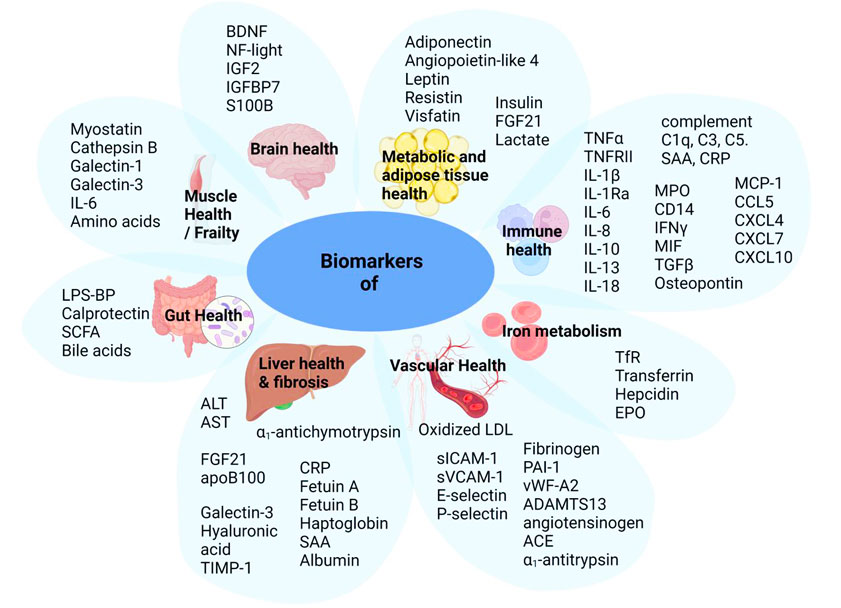in vivo MASH (NASH) model, Liver on a Chip, MASH Biomarkers
Translational Research service through Humanized Disease Models
Overview: in vivo MASH (NASH) model
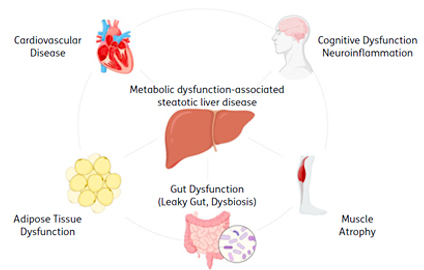
Metabolic Dysfunction Associated Steatohepatitis (MASH) is one of the most prevalent chronic liver diseases, which is closely associated with obesity, insulin resistance and dyslipidemia. These important features therefore need to be reflected in a preclinical model as well. Based on 25 years of research on translational metabolic disease models, TNO has developed the Ldlr-/-.Leiden MASH mouse model that accurately mimics the etiology and pathology of MASH and fibrosis in humans. By using a high-fat diet, with a macronutrient composition comparable to human diets (e.g., without added cholesterol), the Ldlr-/-.Leiden MASH mouse model develops obesity, insulin resistance, adipose tissue inflammation, increased gut permeability with altered microbiota composition, and MASH with bridging fibrosis [F3 stage].
Features:the Ldlr-/-.Leiden MASH mouse model
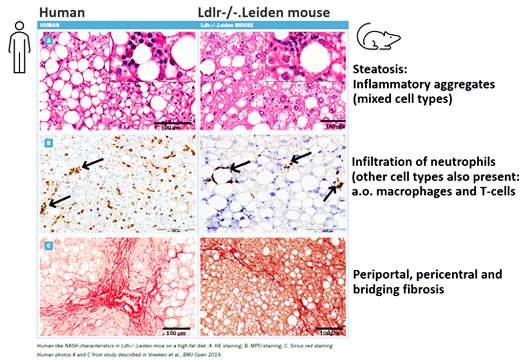
● Translational disease induction and clinical phenotype
● Severe obesity (with adipose tissue inflammation)
● Insulin resistance
● Hyperlipidemia (humanized lipoprotein profiles), high triglycerides, high (V)LDL, low HDL)
● Intact de novo cholesterol synthesis and de novo lipogenesis (DNL)
● Translational histology: steatosis, inflammatory aggregates and bridging fibrosis (up to F3)
● Atherosclerosis development
● Translational underlying pathways, verified on transcriptomics, proteomics and metabolomics level
● Extensive validation with multiple interventions (including the FDA approved drug)
● Metabolic overload-induced complications in multiple organs
● the mouse contains 262 high-impact SNPs. In humans, these SNPs associate with human health & disease processes (e.g. mitochondrial function, bilirubin metabolism, detoxification, inflammation, etc).
Additional obesity-associated endpoints:
● Insulin resistance and visceral adipose tissue inflammation
● Gut permeability
● Muscle atrophy
● Neuroinflammation (Brain)
● Vascular disease (Atherosclerosis)
Time lines・Readout Parameters ; The Ldlr-/-.Leiden MASH mouse model
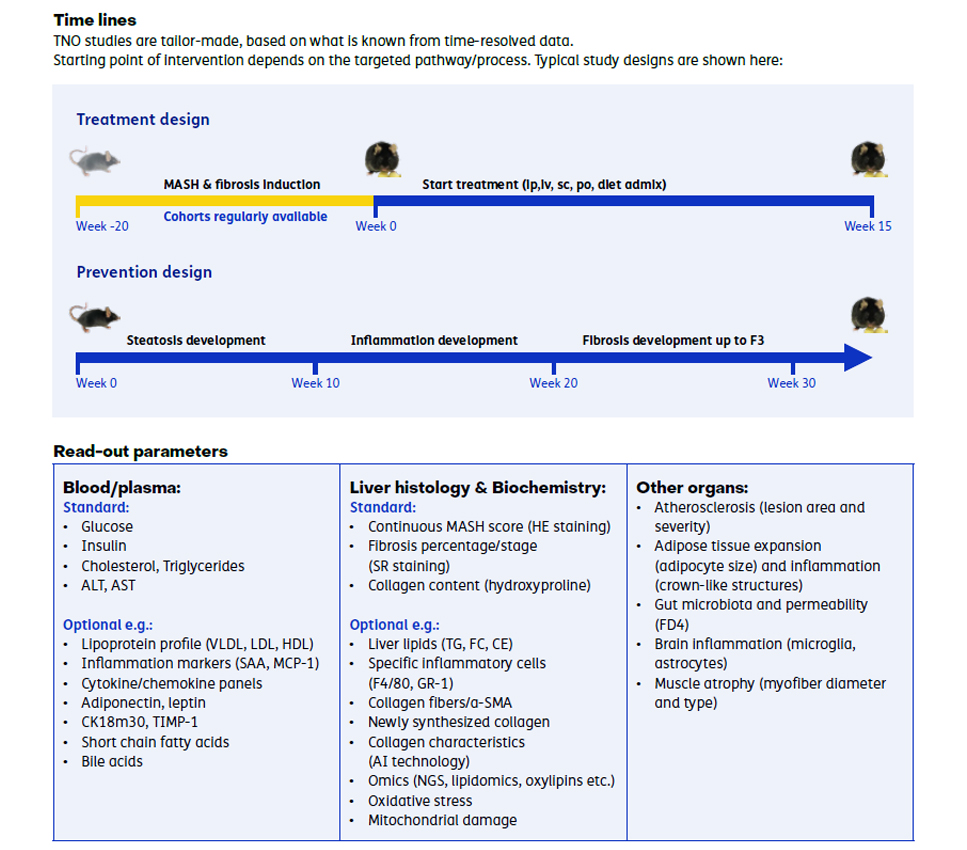
The Ldlr-/-.Leiden MASH model has been validated with many different interventions
| Intervention | Target | Publication |
|---|---|---|
| Resmetirom | THR-β | Poster at EASL, 2024 |
| FGF21 mimetic | Bispecific anti-FGF21-β klotho (KLB) agonist | FASEB Journal. Oct 2024 |
| FASN Inhibitor | De novo lipogenesis | Poster at EASL 2024 |
| DGAT2 inhibitor | De novo lipogenesis | In preparation |
| Firsocostat (ACC inhibitor) | De novo lipogenesis | Poster at EASL 2024 |
| Semaglutide | GLP-1 | Inia et al., Int J of Mol Sci 2023 |
| msR4M-L1 | MIF/CXCR4 inhibition | Poster at EASL 2025 |
| Cenicriviroc | CCR2 & CCR5 | Poster at EASL, 2024 |
| OCA, Cenicriviroc and Pioglitazone | Fibrogenic Gene Signature | FASEB Journal. June 2024 |
| Repeated weight cycling (yo yo dieting) | Metabolism | FASEB Journal. April 2024 |
| Caspase-1 inhibitor | Caspase 1 | Morrison, Int J Obes 2016 |
| Antioxidants (olive oil polyphenols) |
Oxidative stress | Luque-Sierra et al., Mol Nutr Food Res, 2018 Alvarez-Amor et al., Nature Sci Rep. 2021 |
| Rosi-, Pioglitazone | PPAR-γ | Mulder et al., Nat Sci Rep 2016 & in-house |
| Lanifibranor | PPARs | In preparation |
| EPA, DHA from krill oil | PPARs, oxylipins, resolvins | Gart et al., Nutrients 2021 |
| Obeticholic acid | FXR | van den Hoek et al., Cells Sep, 2020 |
| Volixibat | IBAT | Salic et al., PLoS One, 2019 |
| Butyric acid | i.a. TGF-β fibrosis sign. | Arnoldussen et al., Int J Obes 2017 Gart et al., Biomedicines 2021 |
| Propionic acid | TCA cycle | Gart et al., FASEB J 2020 |
| L-carnitine and nicotinamide riboside | β-oxidation, mitochondria | Salic and Gart et al., Int J Mol Sc 2019 |
| Casein hydrolysate | i.a. lipid modulators | Schoemaker et al., PLoS One 2017 |
| Branched chain amino acids | Mitochondria, TCA cycle | Gart et al., FASEB J. 2022 van den Hoek et al., Metabolism 2021 |
| Milk-fat globule membrane | Metabolism | Arnoldussen et al., Int J Obes 2021 |
| Natural cholesterol lowering compounds | Neutrophils | Morrison et al., Front Endocrinol 2021 |
| Translation to Human | Translational Value | Head to head with 1099 patients |
● Recent paper in the FASEB Journal (Jun, 2025);
Fibrogenic Gene Signature as Early Prediction for the Efficacy of Pharmacological Interventions for MASH-Associated Fibrosis.
● Recent paper in Heliyon (Mar, 2023);
Translational characterization of the temporal dynamics of metabolic dysfunctions in liver, adipose tissue and the gut during diet-induced NASH development in Ldlr-/-.Leiden mice.
● Recent paper in Biomedicine (Jun, 2025);
Improved Translational Relevance of In Vitro Fibrosis Models by Integrating IOX2-Mediated Hypoxia-Mimicking Pathways
● Recent paper in the FASEB Journal. (Oct, 2024);
Therapeutic effects of FGF21 mimetic bFKB1 on MASH and atherosclerosis in Ldlr-/-.Leiden mice.
● Recent paper in Nature comm (May, 2024);
Development of a novel non-invasive biomarker panel for hepatic fibrosis in MASLD.
● Other MASH related publication list (pdf)
TNO presented the following four posters at EASL congress in Milan, Italy (June 5th to 8th, 2024).
● Resmetirom protects against diet-induced MASLD and reduces atherogenic risk factors in obese Ldlr-/-.Leiden mice.
● Metabolic flux analysis using a 14C microtracer approach combined with accelerator mass spectrometry analysis.
- a proof of concept study on de novo lipogenesis.
● Development of a novel non-invasive biomarker panel for hepatic fibrosis in MASLD.
● Treatment with the CCR2/CCR5 antagonist Cenicriviroc does not affect MASH and fibrosis development in Ldlr-/-.Leiden mice,
translational to clinical phase 3 trial results.
Liver-on-a-Chip・ Cell model for liver fibrosis
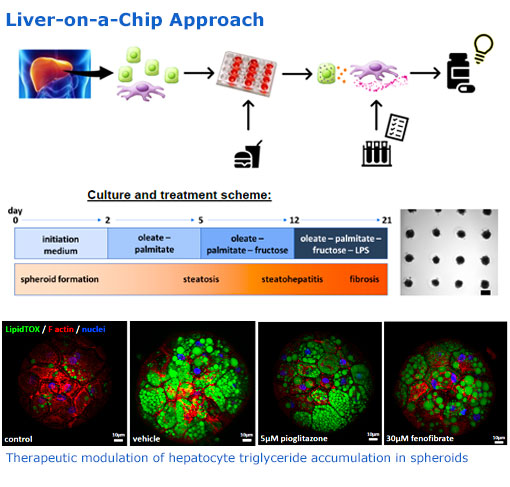
We have developed a liver-on-a-chip model that exhibits MASH / liver fibrosis. By adding oleate and palmitate and later fructose, steatosis and steatohepatitis are induced. Adding also LPS leads to the induction of fibrosis.
This 3D liver spheroid model uses human hepatocytes, stellate cells and Kupffer cells. The model is sensitive to reference compounds such as pioglitazone and fenofibrate.
Summary:
・A diet-induced disease-mimicking 3D in vitro model, closely resembling the pathophysiology of liver steatosis and early fibrosis was developed;
・Liver spheroids composed of primary hepatocytes, stellate and Kupffer cells exhibit expected cell function for at least 21 days;
・The steatosis and steatohepatitis induced by fatty acids and fructose can be modulated by model drugs;
● Development of a disease-mimicking model for NASH and fibrosis in a triple cell-type, spheroid-based liver-on-chip platform with microfluidics.(Poster)
Flux Analysis using 14C and AMS; De Novo Lipogenesis, Muscle Protein Turnover, etc
Metabolic flux measurements play an important role in advancing our understanding of (patho)physiology, disease mechanisms and the development of new therapeutics.
By incorporating stable or radioactive isotopes into specific molecules (tracers), the distribution and fate of the isotope can be followed ? thereby providing insight into the movement and metabolic transformation of biomolecules.
An isotope that is frequently used for such analyses is 13C, which is analyzed by isotope ratio mass spectrometry. The high natural abundance of 13C (~1%) requires the use of large amounts of labelled substrates, especially in clinical studies.
An alternative isotope is 14C, which has an extremely low natural abundance (ca. one in a trillion). In combination with analysis by extremely sensitive accelerator mass spectrometry (AMS), this enables the detection of very small amounts of 14C-labeled product/biomarker at very low (microtrace) amounts of labelled substrate administration.
Application
● De Novo Lipogenesis (DNL)
● HDL funcitionality / Reverse Cholesterol Transport
● Muscle Protein Synthesis & Breakdown (combined 14C and D2O analysis)
● Glucose Metabolism (DNL, conversion to fluctose)
Technical info:
●
Flux Analysis using 14C and AMS
Biomarkers for MASLD・MASH
Fibrosis is the main determinant for mortality and is therefore an important clinical readout. Detection of fibrosis via a liver biopsy is still the golden standard but this is an invasive procedure with risk for complications, sampling and reading errors.
Fibrosis is a dynamic process and currently no validated diagnostic/prognostic methods exist, especially biomarkers which can detect the early onset and progression of fibrosis.
We aim to identify a mechanism-based biomarker panel which is prognostic for MASLD-related fibrosis and enables early identification of people at risk with active fibrogenesis.
By integration of mechanistic mouse studies and human clinical samples we identified a set of circulating proteins related to the active fibrogenesis process.
● Hepatic molecular signature in a translational NASH model as an early screening tool for novel NASH therapeutics.(Poster)
● Early prediction of progressive fibrogenesis in NAFLD-NASH patients using blood-based biomarkers.(Poster)
2025.8.20 | TNO has published a research paper in the International Journal of Molecular Science entitled Biomarkers of Metabolism and Inflammation in Individuals with Obesity and Normal Weight: A Comparative Analysis Exploring Sex Differences.
In this study, we analyzed over 90 biomarkers from healthy normal-weight and obese individuals using ELISA and electrochemiluminescence.
The results revealed that many biomarkers associated with chronic inflammation and metabolic disorders, such as adipokines and cytokines, were elevated in obese individuals. The study also suggested potential sex differences in biomarker levels in both groups.
This dataset not only assists researchers in selecting appropriate biomarkers for their own studies but also highlights the importance of considering sex differences in future research.
